Abstract
Carrying the cytosine-adenosine (CA)19 repeat polymorphism in insulin-like growth factor-1 (IGF1) is associated with lower serum proteins and decreased prostate cancer risk. Carrying the -202A/C genotype in insulin-like growth factor binding protein-3 (IGFBP3) also has been associated with lower serum levels of the binding protein. However, the association between this variant and prostate cancer is inconsistent. To test the hypothesis that inconsistencies are partly due to cancer grade-specific differences in strength and direction of associations, we reanalyzed data from our previous Durham Veterans Administration Hospital study of blacks and whites comprising 47 cases (19 African Americans) with Gleason sum > or = 7, 50 cases (30 African Americans) with Gleason sum < 7 and 93 controls (49 African Americans). Compared to controls, the association between carrying the IGFBP3 C allele and prostate cancer risk was in OR(Low-Gleason) = 4.0; 95% CI: 1.4-12.3 compared to OR(High-Gleason) = 1.0; 95% CI: 0.4-2.2. Association patterns were similar in African Americans (OR(Low-Gleason) = 3.6; 95% CI: 1.0-13.2 vs. OR(High-Gleason) = 1.4; 95% CI: 0.4-2.3) and whites (OR(Low-Gleason) = 5.6; 95% CI: 0.6-49.0 vs. OR(High-Gleason) = 0.6; 95% CI: 0.2-2.2). The inverse association between carrying the IGF1 (CA)19 repeat variant did not vary by grade or ethnicity. If confirmed in larger studies, these findings support the hypothesis that the association between IGFBP3 C allele and prostate cancer is grade specific in both ethnic groups.
Full text
PDF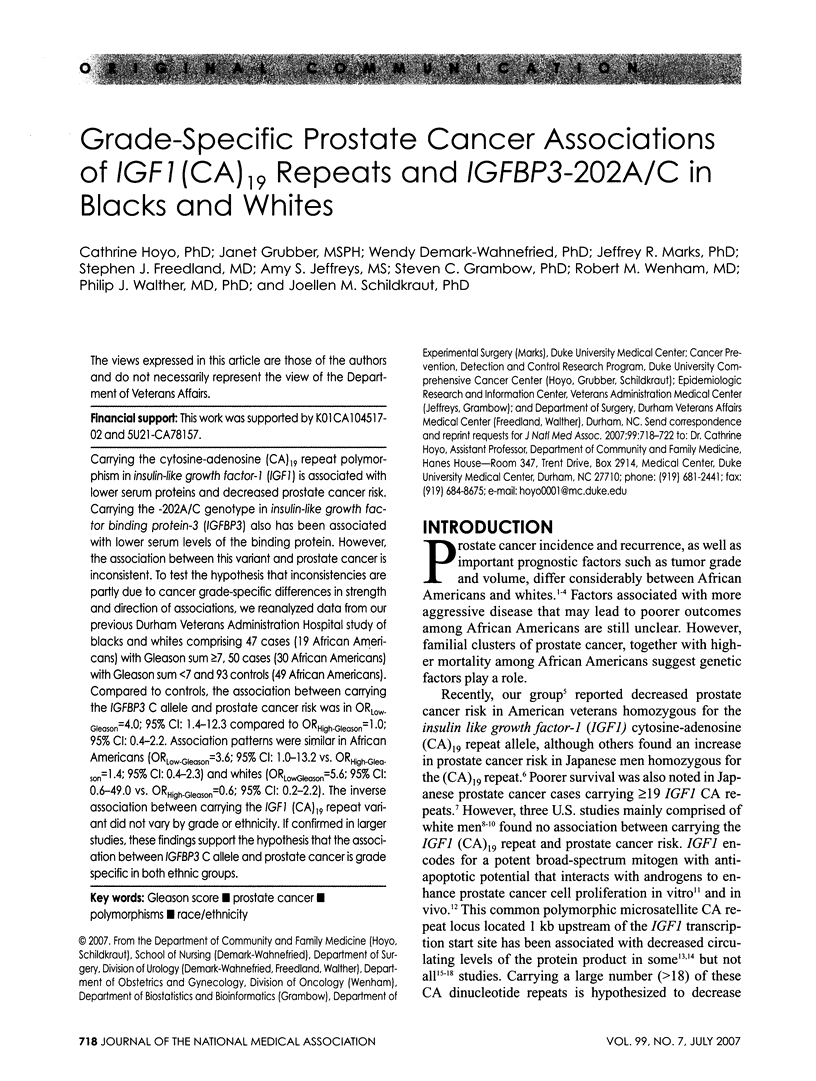
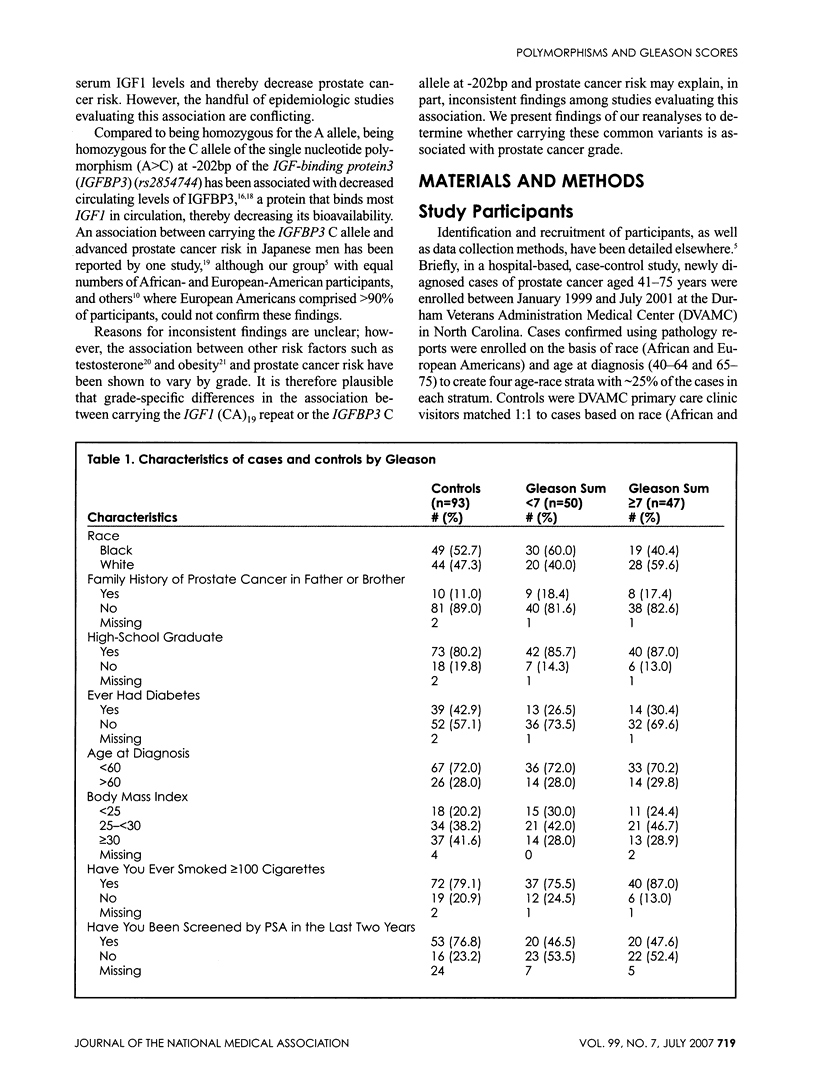
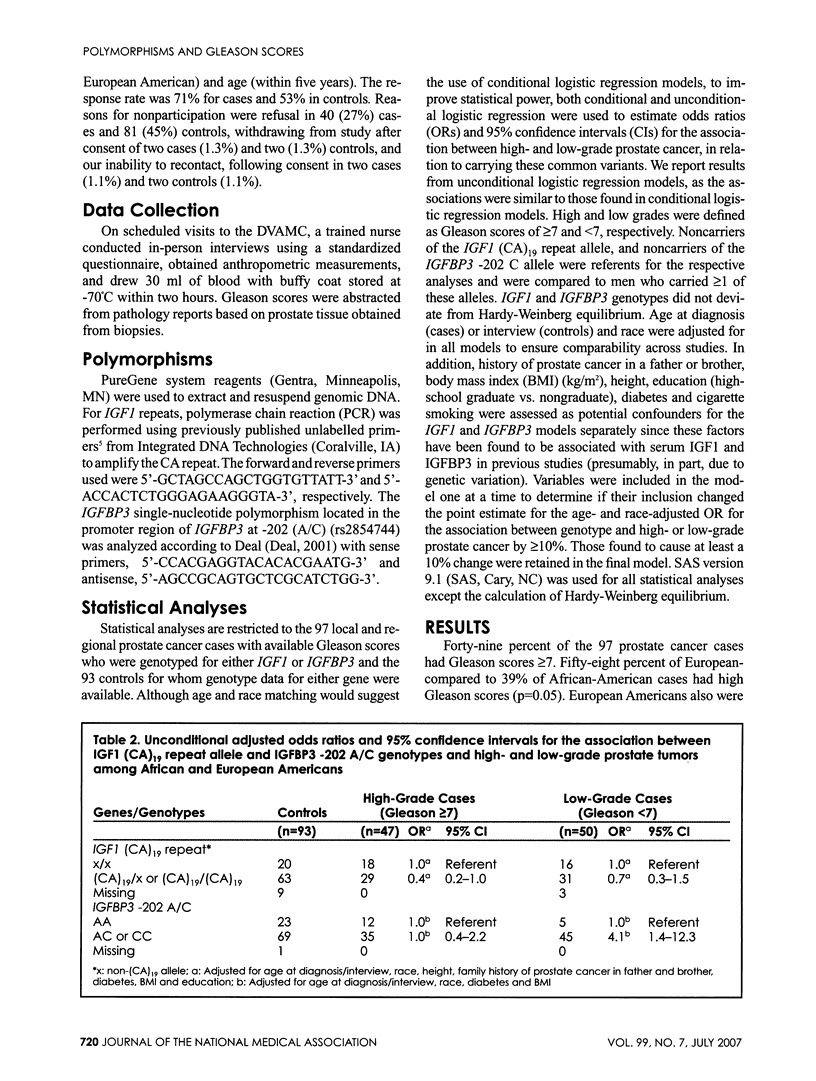
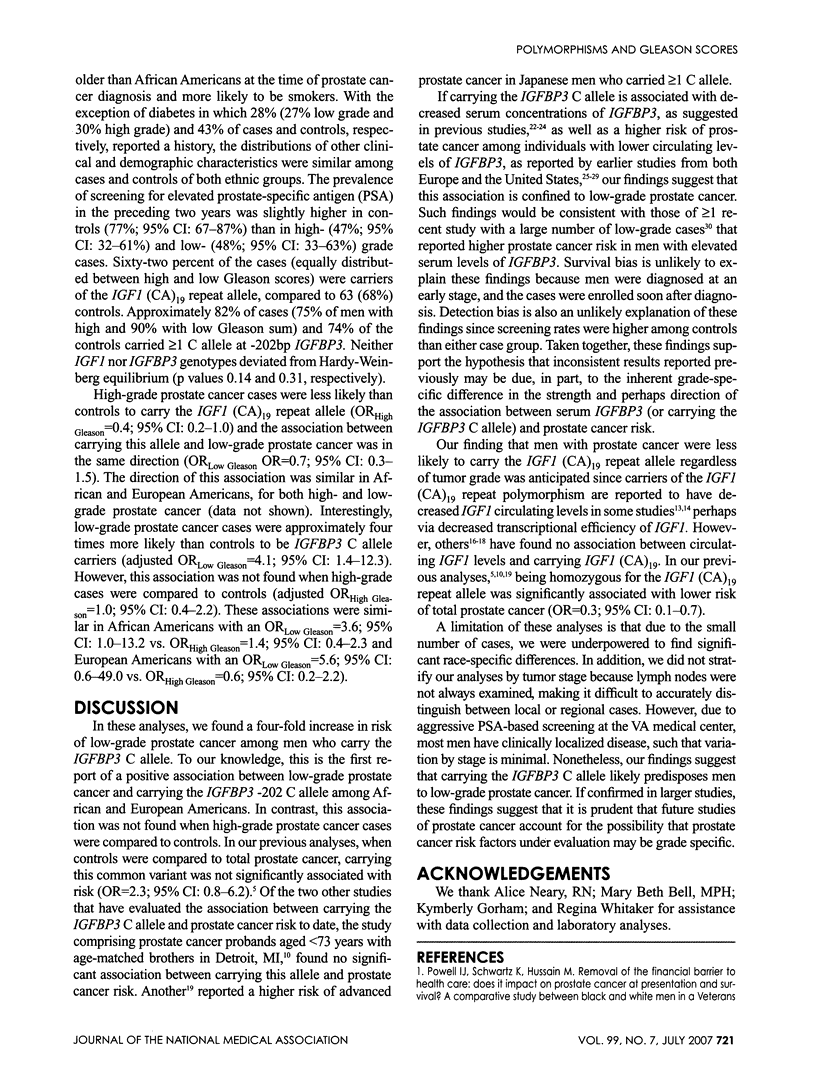
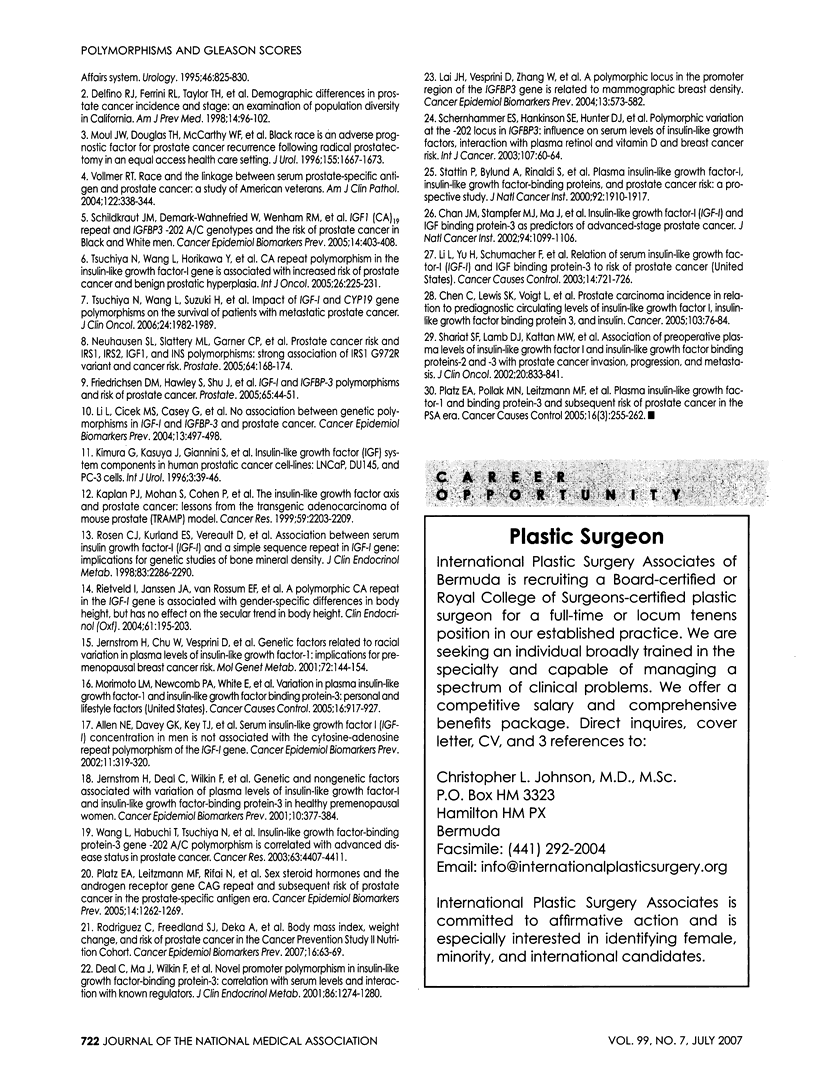
Selected References
These references are in PubMed. This may not be the complete list of references from this article.
- Allen Naomi E., Davey Gwyneth K., Key Timothy J., Zhang Shiyu, Narod Steven A. Serum insulin-like growth factor I (IGF-I) concentration in men is not associated with the cytosine-adenosine repeat polymorphism of the IGF-I gene. Cancer Epidemiol Biomarkers Prev. 2002 Mar;11(3):319–320. [PubMed] [Google Scholar]
- Chan June M., Stampfer Meir J., Ma Jing, Gann Peter, Gaziano J. Michael, Pollak Michael, Giovannucci Edward. Insulin-like growth factor-I (IGF-I) and IGF binding protein-3 as predictors of advanced-stage prostate cancer. J Natl Cancer Inst. 2002 Jul 17;94(14):1099–1106. doi: 10.1093/jnci/94.14.1099. [DOI] [PubMed] [Google Scholar]
- Chen Chu, Lewis S. Kay, Voigt Lynda, Fitzpatrick Annette, Plymate Stephen R., Weiss Noel S. Prostate carcinoma incidence in relation to prediagnostic circulating levels of insulin-like growth factor I, insulin-like growth factor binding protein 3, and insulin. Cancer. 2005 Jan 1;103(1):76–84. doi: 10.1002/cncr.20727. [DOI] [PubMed] [Google Scholar]
- Deal C., Ma J., Wilkin F., Paquette J., Rozen F., Ge B., Hudson T., Stampfer M., Pollak M. Novel promoter polymorphism in insulin-like growth factor-binding protein-3: correlation with serum levels and interaction with known regulators. J Clin Endocrinol Metab. 2001 Mar;86(3):1274–1280. doi: 10.1210/jcem.86.3.7280. [DOI] [PubMed] [Google Scholar]
- Delfino R. J., Ferrini R. L., Taylor T. H., Howe S., Anton-Culver H. Demographic differences in prostate cancer incidence and stage: an examination of population diversity in California. Am J Prev Med. 1998 Feb;14(2):96–102. doi: 10.1016/s0749-3797(97)00014-7. [DOI] [PubMed] [Google Scholar]
- Friedrichsen Danielle M., Hawley Sarah, Shu Jainfen, Humphrey Mariela, Sabacan Leah, Iwasaki Lori, Etzioni Ruth, Ostrander Elaine A., Stanford Janet L. IGF-I and IGFBP-3 polymorphisms and risk of prostate cancer. Prostate. 2005 Sep 15;65(1):44–51. doi: 10.1002/pros.20259. [DOI] [PubMed] [Google Scholar]
- Jernström H., Chu W., Vesprini D., Tao Y., Majeed N., Deal C., Pollak M., Narod S. A. Genetic factors related to racial variation in plasma levels of insulin-like growth factor-1: implications for premenopausal breast cancer risk. Mol Genet Metab. 2001 Feb;72(2):144–154. doi: 10.1006/mgme.2000.3130. [DOI] [PubMed] [Google Scholar]
- Jernström H., Deal C., Wilkin F., Chu W., Tao Y., Majeed N., Hudson T., Narod S. A., Pollak M. Genetic and nongenetic factors associated with variation of plasma levels of insulin-like growth factor-I and insulin-like growth factor-binding protein-3 in healthy premenopausal women. Cancer Epidemiol Biomarkers Prev. 2001 Apr;10(4):377–384. [PubMed] [Google Scholar]
- Kaplan P. J., Mohan S., Cohen P., Foster B. A., Greenberg N. M. The insulin-like growth factor axis and prostate cancer: lessons from the transgenic adenocarcinoma of mouse prostate (TRAMP) model. Cancer Res. 1999 May 1;59(9):2203–2209. [PubMed] [Google Scholar]
- Kimura G., Kasuya J., Giannini S., Honda Y., Mohan S., Kawachi M., Akimoto M., Fujita-Yamaguchi Y. Insulin-like growth factor (IGF) system components in human prostatic cancer cell-lines: LNCaP, DU145, and PC-3 cells. Int J Urol. 1996 Jan;3(1):39–46. doi: 10.1111/j.1442-2042.1996.tb00628.x. [DOI] [PubMed] [Google Scholar]
- Lai Joe H., Vesprini Danny, Zhang William, Yaffe Martin J., Pollak Michael, Narod Steven A. A polymorphic locus in the promoter region of the IGFBP3 gene is related to mammographic breast density. Cancer Epidemiol Biomarkers Prev. 2004 Apr;13(4):573–582. [PubMed] [Google Scholar]
- Li Li, Cicek Mine S., Casey Graham, Witte John S. No association between genetic polymorphisms in IGF-I and IGFBP-3 and prostate cancer. Cancer Epidemiol Biomarkers Prev. 2004 Mar;13(3):497–498. [PubMed] [Google Scholar]
- Li Li, Yu Herbert, Schumacher Fredrick, Casey Graham, Witte John S. Relation of serum insulin-like growth factor-I (IGF-I) and IGF binding protein-3 to risk of prostate cancer (United States). Cancer Causes Control. 2003 Oct;14(8):721–726. doi: 10.1023/a:1026383824791. [DOI] [PubMed] [Google Scholar]
- Morimoto Libby M., Newcomb Polly A., White Emily, Bigler Jeannette, Potter John D. Variation in plasma insulin-like growth factor-1 and insulin-like growth factor binding protein-3: personal and lifestyle factors (United States). Cancer Causes Control. 2005 Oct;16(8):917–927. doi: 10.1007/s10552-005-2702-3. [DOI] [PubMed] [Google Scholar]
- Moul J. W., Douglas T. H., McCarthy W. F., McLeod D. G. Black race is an adverse prognostic factor for prostate cancer recurrence following radical prostatectomy in an equal access health care setting. J Urol. 1996 May;155(5):1667–1673. [PubMed] [Google Scholar]
- Neuhausen Susan L., Slattery Martha L., Garner Chad P., Ding Yuan C., Hoffman Michael, Brothman Arthur R. Prostate cancer risk and IRS1, IRS2, IGF1, and INS polymorphisms: strong association of IRS1 G972R variant and cancer risk. Prostate. 2005 Jul 1;64(2):168–174. doi: 10.1002/pros.20216. [DOI] [PubMed] [Google Scholar]
- Platz Elizabeth A., Leitzmann Michael F., Rifai Nader, Kantoff Philip W., Chen Yen-Ching, Stampfer Meir J., Willett Walter C., Giovannucci Edward. Sex steroid hormones and the androgen receptor gene CAG repeat and subsequent risk of prostate cancer in the prostate-specific antigen era. Cancer Epidemiol Biomarkers Prev. 2005 May;14(5):1262–1269. doi: 10.1158/1055-9965.EPI-04-0371. [DOI] [PubMed] [Google Scholar]
- Platz Elizabeth A., Pollak Michael N., Leitzmann Michael F., Stampfer Meir J., Willett Walter C., Giovannucci Edward. Plasma insulin-like growth factor-1 and binding protein-3 and subsequent risk of prostate cancer in the PSA era. Cancer Causes Control. 2005 Apr;16(3):255–262. doi: 10.1007/s10552-004-3484-8. [DOI] [PubMed] [Google Scholar]
- Rietveld I., Janssen J. A. M. J. L., van Rossum E. F. C., Houwing-Duistermaat J. J., Rivadeneira F., Hofman A., Pols H. A. P., van Duijn C. M., Lamberts S. W. J. A polymorphic CA repeat in the IGF-I gene is associated with gender-specific differences in body height, but has no effect on the secular trend in body height. Clin Endocrinol (Oxf) 2004 Aug;61(2):195–203. doi: 10.1111/j.1365-2265.2004.02078.x. [DOI] [PubMed] [Google Scholar]
- Rodriguez Carmen, Freedland Stephen J., Deka Anusila, Jacobs Eric J., McCullough Marjorie L., Patel Alpa V., Thun Michael J., Calle Eugenia E. Body mass index, weight change, and risk of prostate cancer in the Cancer Prevention Study II Nutrition Cohort. Cancer Epidemiol Biomarkers Prev. 2006 Dec 19;16(1):63–69. doi: 10.1158/1055-9965.EPI-06-0754. [DOI] [PubMed] [Google Scholar]
- Rosen C. J., Kurland E. S., Vereault D., Adler R. A., Rackoff P. J., Craig W. Y., Witte S., Rogers J., Bilezikian J. P. Association between serum insulin growth factor-I (IGF-I) and a simple sequence repeat in IGF-I gene: implications for genetic studies of bone mineral density. J Clin Endocrinol Metab. 1998 Jul;83(7):2286–2290. doi: 10.1210/jcem.83.7.4964. [DOI] [PubMed] [Google Scholar]
- Schernhammer Eva S., Hankinson Susan E., Hunter David J., Blouin Marie J., Pollak Michael N. Polymorphic variation at the -202 locus in IGFBP3: Influence on serum levels of insulin-like growth factors, interaction with plasma retinol and vitamin D and breast cancer risk. Int J Cancer. 2003 Oct 20;107(1):60–64. doi: 10.1002/ijc.11358. [DOI] [PubMed] [Google Scholar]
- Schildkraut Joellen M., Demark-Wahnefried Wendy, Wenham Robert M., Grubber Janet, Jeffreys Amy S., Grambow Steven C., Marks Jeffrey R., Moorman Patricia G., Hoyo Cathrine, Ali Shazia. IGF1 (CA)19 repeat and IGFBP3 -202 A/C genotypes and the risk of prostate cancer in Black and White men. Cancer Epidemiol Biomarkers Prev. 2005 Feb;14(2):403–408. doi: 10.1158/1055-9965.EPI-04-0426. [DOI] [PubMed] [Google Scholar]
- Shariat Shahrokh F., Lamb Dolores J., Kattan Michael W., Nguyen Cuong, Kim JaHong, Beck Josie, Wheeler Thomas M., Slawin Kevin M. Association of preoperative plasma levels of insulin-like growth factor I and insulin-like growth factor binding proteins-2 and -3 with prostate cancer invasion, progression, and metastasis. J Clin Oncol. 2002 Feb 1;20(3):833–841. doi: 10.1200/JCO.2002.20.3.833. [DOI] [PubMed] [Google Scholar]
- Stattin P., Bylund A., Rinaldi S., Biessy C., Déchaud H., Stenman U. H., Egevad L., Riboli E., Hallmans G., Kaaks R. Plasma insulin-like growth factor-I, insulin-like growth factor-binding proteins, and prostate cancer risk: a prospective study. J Natl Cancer Inst. 2000 Dec 6;92(23):1910–1917. doi: 10.1093/jnci/92.23.1910. [DOI] [PubMed] [Google Scholar]
- Tsuchiya Norihiko, Wang Lizhong, Horikawa Yohei, Inoue Takamitsu, Kakinuma Hideaki, Matsuura Shinobu, Sato Kazunari, Ogawa Osamu, Kato Tetsuro, Habuchi Tomonori. CA repeat polymorphism in the insulin-like growth factor-I gene is associated with increased risk of prostate cancer and benign prostatic hyperplasia. Int J Oncol. 2005 Jan;26(1):225–231. [PubMed] [Google Scholar]
- Tsuchiya Norihiko, Wang Lizhong, Suzuki Hiroyoshi, Segawa Takehiko, Fukuda Hisami, Narita Shintaro, Shimbo Masaki, Kamoto Toshiyuki, Mitsumori Kenji, Ichikawa Tomohiko. Impact of IGF-I and CYP19 gene polymorphisms on the survival of patients with metastatic prostate cancer. J Clin Oncol. 2006 May 1;24(13):1982–1989. doi: 10.1200/JCO.2005.02.9439. [DOI] [PubMed] [Google Scholar]
- Vollmer Robin T. Race and the linkage between serum prostate-specific antigen and prostate cancer: a study of American veterans. Am J Clin Pathol. 2004 Sep;122(3):338–344. doi: 10.1309/QVA7-YRHK-F8VU-CNRV. [DOI] [PubMed] [Google Scholar]
- Wang Lizhong, Habuchi Tomonori, Tsuchiya Norihiko, Mitsumori Kenji, Ohyama Chikara, Sato Kazunari, Kinoshita Hidehumi, Kamoto Toshiyuki, Nakamura Akira, Ogawa Osamu. Insulin-like growth factor-binding protein-3 gene -202 A/C polymorphism is correlated with advanced disease status in prostate cancer. Cancer Res. 2003 Aug 1;63(15):4407–4411. [PubMed] [Google Scholar]


